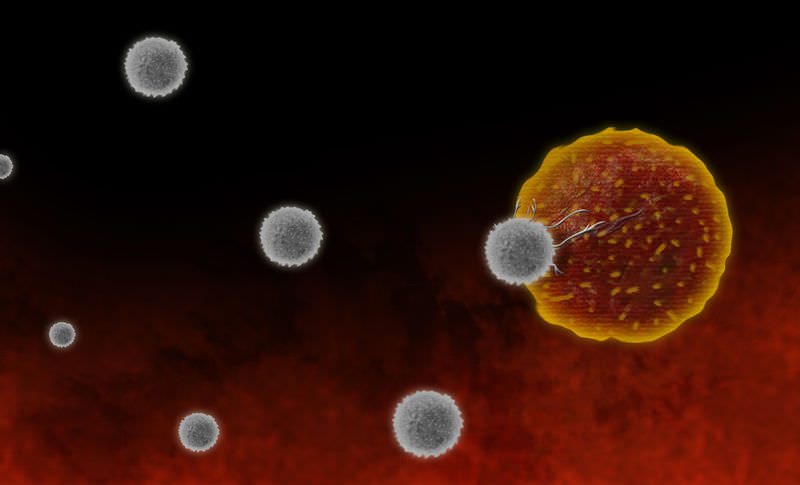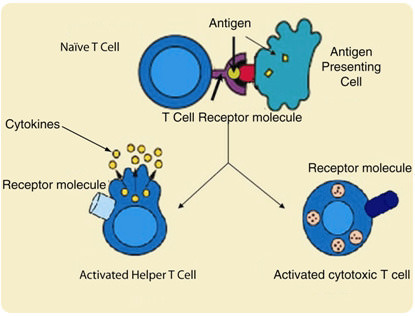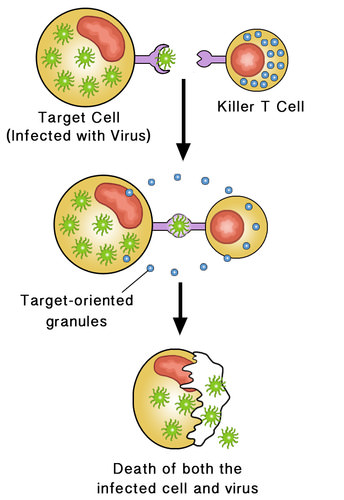13.43: Cell-Mediated Response
- Page ID
- 13320
\( \newcommand{\vecs}[1]{\overset { \scriptstyle \rightharpoonup} {\mathbf{#1}} } \)
\( \newcommand{\vecd}[1]{\overset{-\!-\!\rightharpoonup}{\vphantom{a}\smash {#1}}} \)
\( \newcommand{\dsum}{\displaystyle\sum\limits} \)
\( \newcommand{\dint}{\displaystyle\int\limits} \)
\( \newcommand{\dlim}{\displaystyle\lim\limits} \)
\( \newcommand{\id}{\mathrm{id}}\) \( \newcommand{\Span}{\mathrm{span}}\)
( \newcommand{\kernel}{\mathrm{null}\,}\) \( \newcommand{\range}{\mathrm{range}\,}\)
\( \newcommand{\RealPart}{\mathrm{Re}}\) \( \newcommand{\ImaginaryPart}{\mathrm{Im}}\)
\( \newcommand{\Argument}{\mathrm{Arg}}\) \( \newcommand{\norm}[1]{\| #1 \|}\)
\( \newcommand{\inner}[2]{\langle #1, #2 \rangle}\)
\( \newcommand{\Span}{\mathrm{span}}\)
\( \newcommand{\id}{\mathrm{id}}\)
\( \newcommand{\Span}{\mathrm{span}}\)
\( \newcommand{\kernel}{\mathrm{null}\,}\)
\( \newcommand{\range}{\mathrm{range}\,}\)
\( \newcommand{\RealPart}{\mathrm{Re}}\)
\( \newcommand{\ImaginaryPart}{\mathrm{Im}}\)
\( \newcommand{\Argument}{\mathrm{Arg}}\)
\( \newcommand{\norm}[1]{\| #1 \|}\)
\( \newcommand{\inner}[2]{\langle #1, #2 \rangle}\)
\( \newcommand{\Span}{\mathrm{span}}\) \( \newcommand{\AA}{\unicode[.8,0]{x212B}}\)
\( \newcommand{\vectorA}[1]{\vec{#1}} % arrow\)
\( \newcommand{\vectorAt}[1]{\vec{\text{#1}}} % arrow\)
\( \newcommand{\vectorB}[1]{\overset { \scriptstyle \rightharpoonup} {\mathbf{#1}} } \)
\( \newcommand{\vectorC}[1]{\textbf{#1}} \)
\( \newcommand{\vectorD}[1]{\overrightarrow{#1}} \)
\( \newcommand{\vectorDt}[1]{\overrightarrow{\text{#1}}} \)
\( \newcommand{\vectE}[1]{\overset{-\!-\!\rightharpoonup}{\vphantom{a}\smash{\mathbf {#1}}}} \)
\( \newcommand{\vecs}[1]{\overset { \scriptstyle \rightharpoonup} {\mathbf{#1}} } \)
\(\newcommand{\longvect}{\overrightarrow}\)
\( \newcommand{\vecd}[1]{\overset{-\!-\!\rightharpoonup}{\vphantom{a}\smash {#1}}} \)
\(\newcommand{\avec}{\mathbf a}\) \(\newcommand{\bvec}{\mathbf b}\) \(\newcommand{\cvec}{\mathbf c}\) \(\newcommand{\dvec}{\mathbf d}\) \(\newcommand{\dtil}{\widetilde{\mathbf d}}\) \(\newcommand{\evec}{\mathbf e}\) \(\newcommand{\fvec}{\mathbf f}\) \(\newcommand{\nvec}{\mathbf n}\) \(\newcommand{\pvec}{\mathbf p}\) \(\newcommand{\qvec}{\mathbf q}\) \(\newcommand{\svec}{\mathbf s}\) \(\newcommand{\tvec}{\mathbf t}\) \(\newcommand{\uvec}{\mathbf u}\) \(\newcommand{\vvec}{\mathbf v}\) \(\newcommand{\wvec}{\mathbf w}\) \(\newcommand{\xvec}{\mathbf x}\) \(\newcommand{\yvec}{\mathbf y}\) \(\newcommand{\zvec}{\mathbf z}\) \(\newcommand{\rvec}{\mathbf r}\) \(\newcommand{\mvec}{\mathbf m}\) \(\newcommand{\zerovec}{\mathbf 0}\) \(\newcommand{\onevec}{\mathbf 1}\) \(\newcommand{\real}{\mathbb R}\) \(\newcommand{\twovec}[2]{\left[\begin{array}{r}#1 \\ #2 \end{array}\right]}\) \(\newcommand{\ctwovec}[2]{\left[\begin{array}{c}#1 \\ #2 \end{array}\right]}\) \(\newcommand{\threevec}[3]{\left[\begin{array}{r}#1 \\ #2 \\ #3 \end{array}\right]}\) \(\newcommand{\cthreevec}[3]{\left[\begin{array}{c}#1 \\ #2 \\ #3 \end{array}\right]}\) \(\newcommand{\fourvec}[4]{\left[\begin{array}{r}#1 \\ #2 \\ #3 \\ #4 \end{array}\right]}\) \(\newcommand{\cfourvec}[4]{\left[\begin{array}{c}#1 \\ #2 \\ #3 \\ #4 \end{array}\right]}\) \(\newcommand{\fivevec}[5]{\left[\begin{array}{r}#1 \\ #2 \\ #3 \\ #4 \\ #5 \\ \end{array}\right]}\) \(\newcommand{\cfivevec}[5]{\left[\begin{array}{c}#1 \\ #2 \\ #3 \\ #4 \\ #5 \\ \end{array}\right]}\) \(\newcommand{\mattwo}[4]{\left[\begin{array}{rr}#1 \amp #2 \\ #3 \amp #4 \\ \end{array}\right]}\) \(\newcommand{\laspan}[1]{\text{Span}\{#1\}}\) \(\newcommand{\bcal}{\cal B}\) \(\newcommand{\ccal}{\cal C}\) \(\newcommand{\scal}{\cal S}\) \(\newcommand{\wcal}{\cal W}\) \(\newcommand{\ecal}{\cal E}\) \(\newcommand{\coords}[2]{\left\{#1\right\}_{#2}}\) \(\newcommand{\gray}[1]{\color{gray}{#1}}\) \(\newcommand{\lgray}[1]{\color{lightgray}{#1}}\) \(\newcommand{\rank}{\operatorname{rank}}\) \(\newcommand{\row}{\text{Row}}\) \(\newcommand{\col}{\text{Col}}\) \(\renewcommand{\row}{\text{Row}}\) \(\newcommand{\nul}{\text{Nul}}\) \(\newcommand{\var}{\text{Var}}\) \(\newcommand{\corr}{\text{corr}}\) \(\newcommand{\len}[1]{\left|#1\right|}\) \(\newcommand{\bbar}{\overline{\bvec}}\) \(\newcommand{\bhat}{\widehat{\bvec}}\) \(\newcommand{\bperp}{\bvec^\perp}\) \(\newcommand{\xhat}{\widehat{\xvec}}\) \(\newcommand{\vhat}{\widehat{\vvec}}\) \(\newcommand{\uhat}{\widehat{\uvec}}\) \(\newcommand{\what}{\widehat{\wvec}}\) \(\newcommand{\Sighat}{\widehat{\Sigma}}\) \(\newcommand{\lt}{<}\) \(\newcommand{\gt}{>}\) \(\newcommand{\amp}{&}\) \(\definecolor{fillinmathshade}{gray}{0.9}\)
Do cells really attack other cells?
They sure do. Depicted here is a group of T cells attacking a cancer cell. When they can, the T cells search out and destroy “bad” cells.
Cell-Mediated Immune Response
In addition to the humoral response, the other type of immune response is the cell-mediated immune response, which involves mainly T cells. It leads to the destruction of cells that are infected with viruses. Some cancer cells are also destroyed in this way. There are several different types of T cells involved in a cell-mediated immune response, including helper, cytotoxic, and regulatory T cells.
T Cell Activation
All three types of T cells must be activated by an antigen before they can fight an infection or cancer. T cell activation is illustrated in Figure below. It begins when a B cell or nonspecific leukocyte engulfs a virus and displays its antigens. When the T cell encounters the matching antigen on a leukocyte, it becomes activated. What happens next depends on which type of T cell it is.
 T cell activation requires another leukocyte to engulf a virus and display its antigen.
T cell activation requires another leukocyte to engulf a virus and display its antigen.Helper T Cells
Helper T cells are like the “managers” of the immune response. They secrete cytokines, which activate or control the activities of other lymphocytes. Most helper T cells die out once a pathogen has been cleared from the body, but a few remain as memory cells. These memory cells are ready to produce large numbers of antigen-specific helper T cells like themselves if they are exposed to the same antigen in the future.
Cytotoxic T Cells
Cytotoxic T cells destroy virus-infected cells and some cancer cells. Once activated, a cytotoxic T cell divides rapidly and produces an “army” of cells identical to itself. These cells travel throughout the body “searching” for more cells to destroy. Figure below shows how a cytotoxic T cell destroys a body cell infected with viruses. This T cell releases toxins that form pores in the membrane of the infected cell. This causes the cell to burst, destroying both the cell and the viruses inside it.
 A cytotoxic T cell releases toxins that destroy an infected body cell and the viruses it contains.
A cytotoxic T cell releases toxins that destroy an infected body cell and the viruses it contains.After an infection has been brought under control, most cytotoxic T cells die off. However, a few remain as memory cells. If the same pathogen enters the body again, the memory cells mount a rapid immune response. They quickly produce many copies of cytotoxic T cells specific to the antigen of that pathogen.
Regulatory T Cells
Regulatory T cells are responsible for ending the cell-mediated immune response after an infection has been curbed. They also suppress T cells that mistakenly react against self antigens. What might happen if these T cells were not suppressed?
Summary
- Activated T cells destroy certain cancer cells and cells infected by viruses.
- Memory T cells remain in the body after the immune response and provide antigen-specific immunity to the virus.
Review
- Describe one way that cytotoxic T cells destroy cells infected with viruses.
- What are regulatory T cells?
Resources
| Image | Reference | Attributions |
 |
[Figure 1] | Credit: Laura Guerin;User:Fvasconcellos/Wikimedia Commons Source: CK-12 Foundation ; commons.wikimedia.org/wiki/File:Antibody.svg License: Public Domain |
 |
[Figure 2] | Credit: Courtesy of the National Institutes of Health and User:DO11.10/Wikimedia Commons;User:Fvasconcellos/Wikimedia Commons Source: commons.wikimedia.org/wiki/File:Antigen_presentation.jpg ; commons.wikimedia.org/wiki/File:Antibody.svg License: Public Domain |
 |
[Figure 3] | Credit: Laura Guerin;User:Fvasconcellos/Wikimedia Commons Source: CK-12 Foundation ; commons.wikimedia.org/wiki/File:Antibody.svg License: CC BY-NC 3.0; Public Domain |

